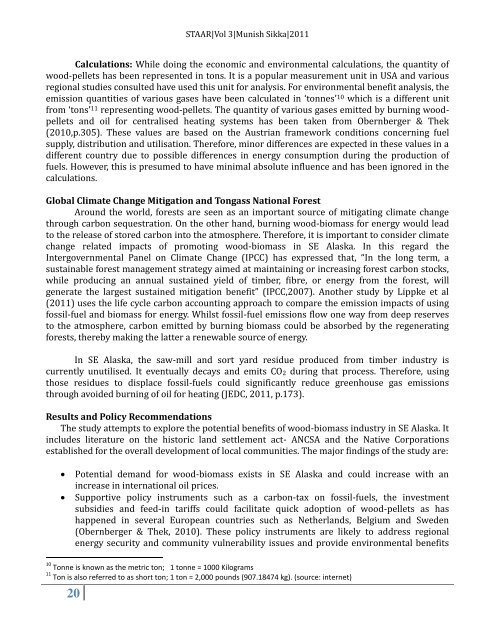STAAR Volume 3 - St. Anne's MCR
STAAR Volume 3 - St. Anne's MCR
STAAR Volume 3 - St. Anne's MCR
Create successful ePaper yourself
Turn your PDF publications into a flip-book with our unique Google optimized e-Paper software.
20<br />
<strong>STAAR</strong>|Vol 3|Munish Sikka|2011<br />
Calculations: While doing the economic and environmental calculations, the quantity of<br />
wood-pellets has been represented in tons. It is a popular measurement unit in USA and various<br />
regional studies consulted have used this unit for analysis. For environmental benefit analysis, the<br />
emission quantities of various gases have been calculated in ‘tonnes’ 10 which is a different unit<br />
from ‘tons’ 11 representing wood-pellets. The quantity of various gases emitted by burning woodpellets<br />
and oil for centralised heating systems has been taken from Obernberger & Thek<br />
(2010,p.305). These values are based on the Austrian framework conditions concerning fuel<br />
supply, distribution and utilisation. Therefore, minor differences are expected in these values in a<br />
different country due to possible differences in energy consumption during the production of<br />
fuels. However, this is presumed to have minimal absolute influence and has been ignored in the<br />
calculations.<br />
Global Climate Change Mitigation and Tongass National Forest<br />
Around the world, forests are seen as an important source of mitigating climate change<br />
through carbon sequestration. On the other hand, burning wood-biomass for energy would lead<br />
to the release of stored carbon into the atmosphere. Therefore, it is important to consider climate<br />
change related impacts of promoting wood-biomass in SE Alaska. In this regard the<br />
Intergovernmental Panel on Climate Change (IPCC) has expressed that, “In the long term, a<br />
sustainable forest management strategy aimed at maintaining or increasing forest carbon stocks,<br />
while producing an annual sustained yield of timber, fibre, or energy from the forest, will<br />
generate the largest sustained mitigation benefit” (IPCC,2007). Another study by Lippke et al<br />
(2011) uses the life cycle carbon accounting approach to compare the emission impacts of using<br />
fossil-fuel and biomass for energy. Whilst fossil-fuel emissions flow one way from deep reserves<br />
to the atmosphere, carbon emitted by burning biomass could be absorbed by the regenerating<br />
forests, thereby making the latter a renewable source of energy.<br />
In SE Alaska, the saw-mill and sort yard residue produced from timber industry is<br />
currently unutilised. It eventually decays and emits CO2 during that process. Therefore, using<br />
those residues to displace fossil-fuels could significantly reduce greenhouse gas emissions<br />
through avoided burning of oil for heating (JEDC, 2011, p.173).<br />
Results and Policy Recommendations<br />
The study attempts to explore the potential benefits of wood-biomass industry in SE Alaska. It<br />
includes literature on the historic land settlement act- ANCSA and the Native Corporations<br />
established for the overall development of local communities. The major findings of the study are:<br />
Potential demand for wood-biomass exists in SE Alaska and could increase with an<br />
increase in international oil prices.<br />
Supportive policy instruments such as a carbon-tax on fossil-fuels, the investment<br />
subsidies and feed-in tariffs could facilitate quick adoption of wood-pellets as has<br />
happened in several European countries such as Netherlands, Belgium and Sweden<br />
(Obernberger & Thek, 2010). These policy instruments are likely to address regional<br />
energy security and community vulnerability issues and provide environmental benefits<br />
10 Tonne is known as the metric ton; 1 tonne = 1000 Kilograms<br />
11 Ton is also referred to as short ton; 1 ton = 2,000 pounds (907.18474 kg). (source: internet)


